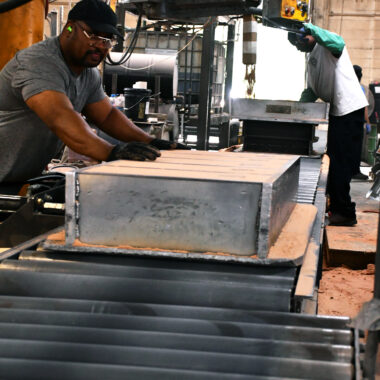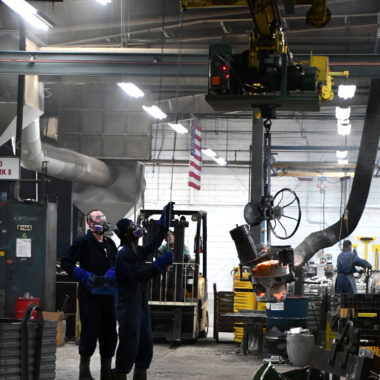Casting Aluminum Illinois: Your Comprehensive How-To Manual
Casting Aluminum Illinois: Your Comprehensive How-To Manual
Blog Article
Development in Light Weight Aluminum Casting: Cutting-Edge Techniques for Modern Designers
Aluminum casting, a typical production procedure, has seen a remarkable improvement in current years with the introduction of sophisticated techniques that satisfy the demands of modern-day makers. From innovative 3D printing approaches that press the boundaries of layout to the assimilation of automation and robotics streamlining manufacturing, the landscape of aluminum spreading is progressing quickly. However, what genuinely establishes these advancements apart are the sustainable aluminum alloys being developed and the high-pressure die spreading strategies that are changing the sector. Join us as we explore the forefront of aluminum casting innovation, where technology meets imagination to redefine what is possible on the planet of steel casting.

Advanced 3D Printing Strategies
Utilizing innovative additive production procedures, progressed 3D printing techniques have revolutionized the manufacturing of intricate and personalized light weight aluminum elements. By employing high-precision printers that can deal with aluminum powders or filaments, makers can develop intricate geometries and layouts that were previously unattainable through traditional manufacturing approaches.
Among the crucial benefits of sophisticated 3D printing in light weight aluminum component manufacturing is the capability to accomplish lightweight yet long lasting frameworks. This is specifically helpful in markets such as aerospace and automobile, where weight decrease is vital for improving gas effectiveness and overall efficiency. Furthermore, the personalization alternatives used by 3D printing enable the production of one-of-a-kind and tailored parts that satisfy specific demands, bring about improved capability and efficiency.
Additionally, the effectiveness of the 3D printing procedure minimizes product waste and reduces the total production time, making it a cost-effective solution for manufacturing light weight aluminum components. As technology proceeds to development, the abilities of 3D printing in light weight aluminum manufacturing are expected to expand, supplying also better possibilities for advancement in different markets.
Computer-Aided Style Advancements
With the developments in sophisticated 3D printing methods for light weight aluminum parts, the integration of Computer-Aided Layout (CAD) software has become significantly essential in driving technology and effectiveness in the production procedure. CAD technologies have actually transformed the way developers and designers create light weight aluminum casting mold and mildews by offering exact electronic modeling abilities. These software program tools permit for the creation of complex layouts and simulations that enhance the spreading procedure, leading to better parts.
One of the crucial benefits of CAD in light weight aluminum spreading is the ability to identify potential problems early in the layout phase, decreasing pricey errors and rework during manufacturing. By simulating the casting process essentially, developers can analyze elements such as cooling down rates, material flow, and architectural honesty prior to a physical mold and mildew is created. This positive technique not just conserves time and sources but also guarantees that the final light weight aluminum parts fulfill the wanted specifications.
Moreover, CAD software application allows fast versions and adjustments to styles, promoting quick prototyping and modification to fulfill details requirements. By leveraging CAD innovations in aluminum spreading, manufacturers can streamline their procedures, boost item top quality, and remain at the leading edge of advancement in the market.
High-Pressure Die Casting Techniques
High-pressure die casting methods are extensively identified for their effectiveness and accuracy in creating complex aluminum parts. By using high pressure to force molten light weight aluminum right into elaborate molds at quick rates, this method enables the creation of thorough and dimensionally precise parts. One of the vital benefits of high-pressure die casting is its capacity to create get rid of slim wall surfaces and fine information, making it ideal for applications where light-weight yet strong components are essential.
The procedure begins with the prep work of the die, which is generally made from set tool steel and is composed of two fifty percents that create the preferred component shape. The liquified light weight aluminum is then infused into the die tooth cavity under high stress, guaranteeing that the product fills all the complex features of the mold. As soon as the aluminum solidifies, the die opens up, disclosing the finished part all set for any needed post-processing.
High-pressure die spreading is typically made use of in various markets, consisting of automotive, aerospace, and electronic devices, where high-volume manufacturing of complex light weight aluminum components is needed. casting aluminum illinois. Its capability to supply tight tolerances, exceptional surface area coatings, and cost-effective manufacturing makes it a recommended selection for modern-day makers aiming to innovate in aluminum casting methods
Lasting Light Weight Aluminum Alloys Growth

One approach to sustainable light weight aluminum alloy development entails incorporating recycled light weight aluminum content into the alloy make-up. By utilizing recycled light weight aluminum, manufacturers can minimize power consumption and greenhouse gas discharges connected with main light weight aluminum production. Furthermore, reusing light weight aluminum helps draw away waste from land fills, adding to a much more round economy.
Moreover, scientists are exploring new alloying aspects and handling techniques to improve the sustainability of aluminum alloys. By enhancing alloy make-ups and manufacturing processes, it is possible to improve the recyclability, resilience, and general ecological efficiency of light weight aluminum items.

Automation and Robotics Assimilation
In the realm of sustainable light weight aluminum alloys advancement, the integration of automation and robotics is changing producing processes, leading the way for increased performance and precision in manufacturing. Automation and robotics are enhancing conventional spreading methods, offering countless benefits to makers in the aluminum industry. By integrating automation into the spreading process, repeated tasks that were when labor-intensive can now be effectively handled by robot systems, reducing the danger of human error and boosting overall efficiency.
Automated systems can function around the clock, making certain a continuous manufacturing cycle that minimizes downtime and maximizes result. Robotics assimilation allows for complicated mold and mildews and intricate layouts to be produced with unparalleled precision, fulfilling the needs of modern-day makers for top notch light weight aluminum components. Additionally, the use of automation in casting operations promotes a safer working environment by lessening the exposure of workers to harmful problems.
Final Thought
To conclude, the advancements in aluminum casting have transformed the manufacturing market. Advanced 3D printing methods, Read Full Article computer-aided style advancements, high-pressure die spreading approaches, lasting light weight aluminum alloys growth, and automation and robotics integration have all added to the modernization of the casting procedure. These cutting-edge techniques have actually made it possible for makers to generate facility and high-quality light weight aluminum items successfully and properly. The future of light weight aluminum casting is brilliant with continuous innovation and technological innovations.
What truly establishes these advancements apart are the sustainable light weight aluminum alloys being established and the high-pressure die casting strategies that are reinventing the market. Join us as we explore the center of aluminum spreading advancement, where technology fulfills imagination to redefine what is feasible in the world of metal casting.
One method to lasting aluminum alloy growth includes incorporating recycled light weight aluminum content right into the alloy composition - casting aluminum Our site illinois. By making use of recycled aluminum, suppliers can decrease power consumption and greenhouse gas exhausts associated with key aluminum manufacturing. Advanced 3D printing techniques, computer-aided style innovations, high-pressure die casting approaches, sustainable light weight aluminum alloys growth, and automation and robotics combination click to read have all added to the innovation of the casting procedure
Report this page